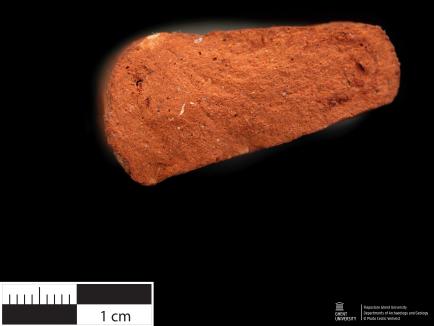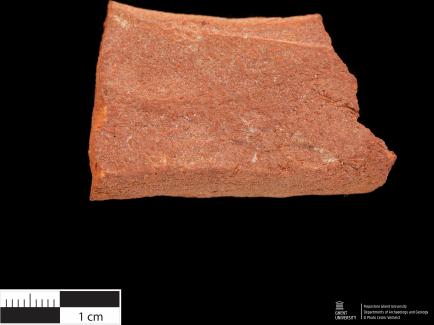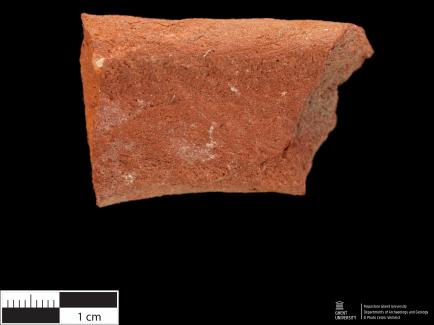Post Medieval - Ceramic building material (7.CBM.BE.0009)
Hand specimen pictures (macro & binocular)
Thin section pictures
Find location
- Category
- Ceramic building material (Post Medieval)
- Fabric name
- Chronology
- Post Medieval > Modern > 1556-1561/1562
- Dating method(-s)
- historical sources, typology, iconography
- Potters' mark
- No
- Additional information
- clay roll fragment, firing aid used to stack the vessels and tiles in the kiln
Find location
- Site type
- Pottery production
- Location
- Belgium; Antwerpen; Antwerpen
- Site name
- Antwerpen, Steenhouwersvest
- Excavation or Survey Team
- Afdeling Opgravingen, Stad Antwerpen
- Additional contextual information
- site code: A117; context information: A117/7/HS9; excavation 1993 (kiln + production waste); attributed to the workshop/pottery company of Lucas Andries (atelier De Goudbloem)
- Surface color
- orange red
- Surface texture
- Rough
- Fracture color
- red
- Inclusions (non-plastics/tempering)
- quartz; amorphous white/beige inclusion (clay ? grog ?); rare black inclusions (?)
- Matrix and voids
- small vesicles
- Diagnostic features
- Additional information
- sample ANTW_SV_ST4
- Flepostore inventory nr.
- ARCH1.L1.C11
- Original inventory nr.
- A0052
- Collection
- Archaeological Department, Ghent University
- Type
- Covered thin section
- Comparable thin section(s)
- Matrix
-
Oxidised orange-red fabric; brown (PPL), dark brown (XP).
Semi-heterogeneous matrix, non-calcerous with no optical activity.
- ca. 45-60% - Inclusions
-
Quartz (++; mono++, poly--), metamorphic rock detritus (+-, low grade), feldspars (-; plagioclase), muscovite mica (+-; el & eq), O/Fe (+), clay pellets (+; iron-rich, large).
The coarse fraction consists of medium sand, the fine fraction consists of very fine to fine sand, bimodal (natural). Grains are generally rounded to subangular. Overall the fabric is very poorly sorted and very poorly orientated, single to double spaced.
- ca. 25-35% - Voids
-
Many small planar voids and few larger vughs, drying cracks in and around clay pellets, poorly aligned, no infill.
- ca. 15-20% - Diagnostic features
- The fabric is characterized by a semi-heterogeneous oxidised matrix with no optical activity and high porosity. Dominant quartz inclusions with frequent opaques/iron oxides and iron-rich clay pellets, common metamorphic rock detritus and muscovite mica, and few feldspars. Overall very poorly sorted fabric.
- Additional information
- Sample type
- Building material (decorative, construction)
- Inventory number
- 7.CBM.BE.0009
- Collection
- Archaeological Department, Ghent University
- Donating institute/person
- Onroerenderfgoeddepot, Stad Antwerpen
- Host collection
- Onroerenderfgoeddepot, Stad Antwerpen
- Other samples available
- No
- Sample collection method
- Archaeological Excavation
Dumortier & Veeckman 1994
- Full reference
-
Dumortier C. & Veeckman J. 1994. Un four de majoliques en activité à Anvers vers 1560. Bulletin van de Koninkljke Musea voor Kunst en Geschiedenis. Jubelpark Brussel 65: 163-217.
Veeckman 1994
- Full reference
-
Veeckman J. 1994. Een majolica-oven aan de Steenhouwersstraat te Antwerpen (Antw.). Archaeologia Mediaevalis 17: 5-7.
Cite this page as: Flepostore - https://flepostore.ugent.be/ceramics/7-cbm-be-0009
Last modified: 2024-04-24.





